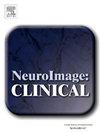1型脊髓小脑共济失调白质改变的模式和动态:弥散加权磁共振成像研究
IF 3.4
2区 医学
Q2 NEUROIMAGING
引用次数: 0
摘要
背景小脑共济失调 1 型(SCA1)是一种罕见的神经退行性疾病。即将开展的临床疾病改变试验需要对疾病进展敏感的生物标志物。方法46名参与者(26名SCA1患者,20名匹配的健康对照组(HC))在两年内的三个时间点接受了3 T MRI检查和共济失调严重程度临床评估(SARA),包括dMRI。利用基于束的空间统计(TBSS)和基于 ROI 的提取对扩散指标(分数各向异性、平均扩散率、径向扩散率、轴向扩散率)进行了检查。结果小脑白质,尤其是所有小脑脚,在所有弥散指标上,SCA1 组和 HC 组在基线时均有显著差异(p < 0.001)。两年后,仅在小脑下丘(ICP)观察到动态变化。然而,疾病早期患者(SARA ≤ 11)亚组的皮质脊髓束(CST)和桥脑交叉束(PCT)出现了显著变化,这表明动态变化是阶段性的。皮质区域在组间未显示横断面差异,但在 SCA1 组的前部和后部区域有显著变化(p < 0.001)。在群体水平上,扩散指标显示出 ICP 和皮质区域的动态效应。处于疾病早期阶段的患者在 CST 和 PCT 中也显示出动态变化。这表明,白质的改变在整个疾病过程中都遵循特定的模式,在针对疾病早期阶段的临床试验中,对白质的测量最为有用。本文章由计算机程序翻译,如有差异,请以英文原文为准。
The pattern and dynamics of white matter alterations in Spinocerebellar ataxia type 1: A diffusion-weighted magnetic resonance imaging study
Background
Spinocerebellar ataxia type 1 (SCA1) is a rare, neurodegenerative disease. Upcoming clinical disease-modifying trials require biomarkers sensitive to disease progression. This study aims to investigate diffusion MRI (dMRI) metrics as a possible outcome measure in such trials.
Methods
46 participants (26 SCA1, 20 matched healthy controls (HC)) underwent 3 T MRI examination and clinical assessment of ataxia severity (SARA) at three timepoints over the duration of two years, including dMRI. Diffusion metrics (fractional anisotropy, mean diffusivity, radial diffusivity, axial diffusivity) were examined using tract-based spatial statistics (TBSS) and ROI-based extraction. Results were evaluated for change over time and relation to disease severity.
Results
Cerebellar white matter, in particular all cerebellar peduncles, showed significant (p < 0.001) differences between SCA1 and HC groups at baseline in all diffusion metrics. After two years, dynamics were only observed in the inferior cerebellar peduncle (ICP). However, a sub-group of early-stage disease patients (SARA ≤ 11) showed significant change in the corticospinal tract (CST) and pontine crossing tract (PCT), indicating stage-dependent dynamics. Cortical regions did not show cross-sectional differences between groups, but did change significantly in both anterior and posterior regions in the SCA1 group (p < 0.001).
Conclusion
SCA1 patients showed ignificantly impaired white matter integrity in the cerebellar regions, when compared to HC. At the group level, diffusion metrics show dynamic effects in the ICP and in cortical regions. Patients in early disease stages furthermore show dynamic change in the CST and PCT. This indicates that white matter alterations follow a specific pattern throughout the disease and that measurements thereof are most useful in clinical trials targeting early disease stages.
求助全文
通过发布文献求助,成功后即可免费获取论文全文。
去求助
来源期刊

Neuroimage-Clinical
NEUROIMAGING-
CiteScore
7.50
自引率
4.80%
发文量
368
审稿时长
52 days
期刊介绍:
NeuroImage: Clinical, a journal of diseases, disorders and syndromes involving the Nervous System, provides a vehicle for communicating important advances in the study of abnormal structure-function relationships of the human nervous system based on imaging.
The focus of NeuroImage: Clinical is on defining changes to the brain associated with primary neurologic and psychiatric diseases and disorders of the nervous system as well as behavioral syndromes and developmental conditions. The main criterion for judging papers is the extent of scientific advancement in the understanding of the pathophysiologic mechanisms of diseases and disorders, in identification of functional models that link clinical signs and symptoms with brain function and in the creation of image based tools applicable to a broad range of clinical needs including diagnosis, monitoring and tracking of illness, predicting therapeutic response and development of new treatments. Papers dealing with structure and function in animal models will also be considered if they reveal mechanisms that can be readily translated to human conditions.
 求助内容:
求助内容: 应助结果提醒方式:
应助结果提醒方式:


